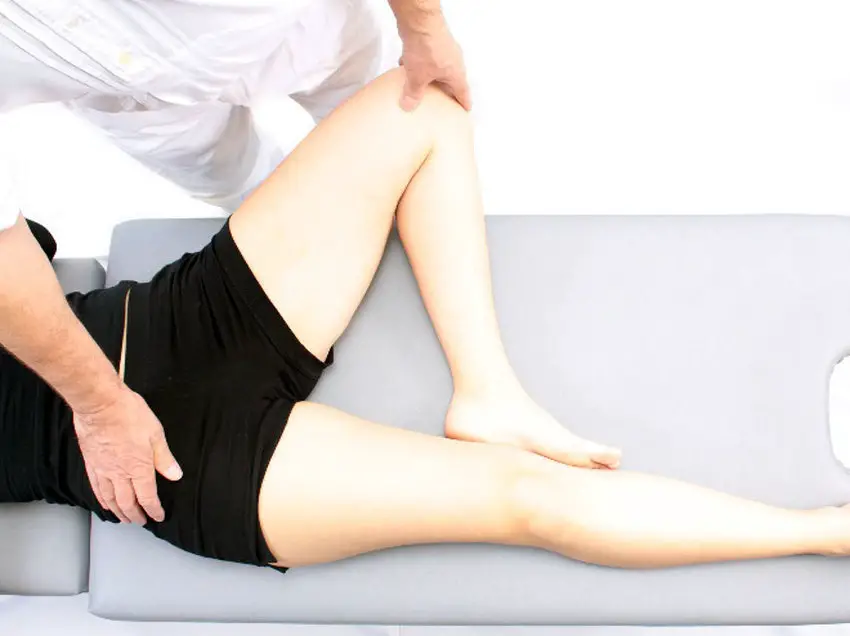Article reviewed and approved by Dr. Ibtissama Boukas, physician specializing in family medicine
Named after the American neurologist Hugh Patrick, the Faber test (also known as the Patrick test or figure 4) is a clinical pain provocation test aimed at diagnosing pathology in the hip, lumbar region or sacroiliac region. This article describes the indications for the test, its procedure and its interpretation.
Anatomy and definition
The hip joint is formed by the head of the femur which articulates with the acetabulum of the pelvis. This joint serves as the main link between the lower limb and the trunk, and generally operates in a closed kinematic chain (it regularly supports the weight of the body when the leg is anchored to the ground).
The possible movements of the hip joint are flexion, extension, abduction, adduction, internal rotation and external rotation. The ligaments in the hip joint work to increase stability, as does the acetabular labrum.
Faber is an acronym for flexion (F), abduction (AB) and external rotation (ER) of the hip where these three combined movements put stress on the previously mentioned joints.
Indications
The Faber test is mainly used to identify hip pathology by exerting stress on the coxo-femoral joint, in addition to soliciting the lumbar region and the sacroiliac joint. Musculoskeletal pathologies can cause pain during the test.
If the pain is felt at the sacroiliac level, this can lead to the following pathologies:
- sacroiliac dysfunction
- ankylosing spondylitis
If the pain is felt in the groin, this can point to the following pathologies:
- psoas tendonitis
- Iliopsoas bursitis
- Hip pathology (Osteoarthritis, labral lesion, synovitis, etc.)
If the pain is felt in the lumbar or buttocks, this can point to the following pathologies:
- Low back pain
- Hip pathology
In conjunction with other tests such as hip mobility and strength, as well as other specific tests, the Faber test can be a useful tool for the practitioner when making the decision to refer for medical imaging or other more in-depth assessments.
Procedure
The patient is placed in the supine position (on the back). The assessed leg is placed in position so as to form a 4 (more specifically, the hip is positioned in flexion, abduction and external rotation). The outer side of the assessed ankle should rest on the opposite thigh after positioning the leg for the Faber test.
While stabilizing the opposite side of the pelvis (at the level of the antero-superior iliac spine), the evaluator exerts a force aimed at pushing the knee of the affected leg towards the table. This is equivalent to a combined movement of flexion, abduction and external rotation. Mini oscillations of low amplitude can be applied at the end of the movement to check if there is provocation of pain.
A Faber test is qualified as positive if it reproduces a characteristic pain (that of which the patient normally complains), or if the range of motion is significantly limited compared to the healthy side.
Conclusion
The FABER test is used in the diagnosis of conditions related to the hip, lumbar or sacroiliac region. This is a quick and easy to perform pain provocation test. Above all, it guides the healthcare professional in their decision-making and clinical reasoning. For example, he can suggest that the practitioner prescribe hip mobility exercises, or refer him to medical imaging to obtain more information on the patient's condition.
References
- https://www.physio-pedia.com/FABER_Test
- https://fpnotebook.com/ortho/Exam/FbrTst.htm
- https://en.wikipedia.org/wiki/Patrick%27s_test
- https://www.researchgate.net/figure/FAbER-test-the-ankle-of-the-side-to-be-tested-on-level-of-the-opposite-patella-the-hip_fig7_325435933
My name is Anas Boukas and I am a physiotherapist. My mission ? Helping people who are suffering before their pain worsens and becomes chronic. I am also of the opinion that an educated patient greatly increases their chances of recovery. This is why I created Healthforall Group, a network of medical sites, in association with several health professionals.
My journey:
Bachelor's and Master's degrees at the University of Montreal , Physiotherapist for CBI Health,
Physiotherapist for The International Physiotherapy Center


